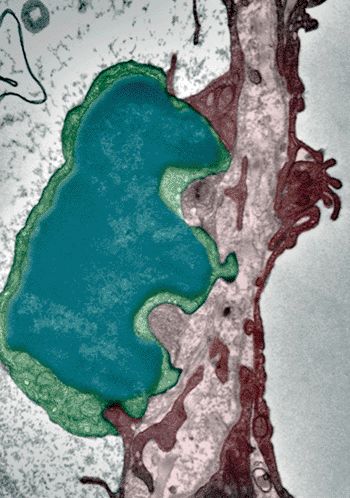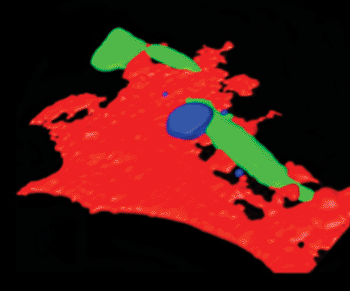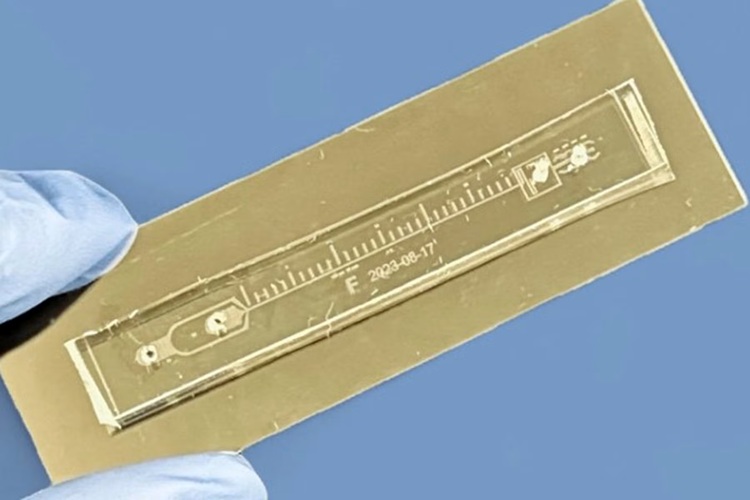Mechanism Discovered for Cancer Cell Metastasis
|
By LabMedica International staff writers Posted on 18 Jul 2012 |

Image: Electron microscopy of a tumor cell (blue, green) on the way to extravasate through an alveolar endothelium blood capillary (purple, red). Tumor cell protrusions are seen forming their way through the endothelial cell (Photo courtesy of the University of Zurich.)

Image: Tumor cells (green) adhere on the endothelium (red) that becomes activated and permeable via CCL2-CCR2 signaling. Tumor cell extravasation is facilitated by recruited monocytic cells (blue). Technique: Adaptation of confocal image stacks creating an artificial surface. (Photo courtesy of the University of Zurich.)
Scientists have for the first time discovered a mechanism by which cancer cells metastasize to other parts of the body, where they form the secondary tumors responsible for the vast majority of cancer-related deaths.
Until now, molecular level processes leading to the metastatic spread into certain organs have been unknown, it being unclear as to how the secondary cells are able to leave the bloodstream and enter the tissue of other organs. A European team of physiologists and neuropathologists, primarily through the University of Zurich (Switzerland), have now identified a biochemical pathway underlying the origin of metastasis formation whereby at least some, if not all, types of cancer cells metastasize out of the bloodstream. The team, led by principal investigators Dr. Lubor Borsig and Dr. Mathias Heikenwalder, demonstrated that intestinal cancer cells manipulate specific “doorman receptors” on the endothelium of the blood vessels.
Elevated levels of the chemokine CCL2 are known to be characteristic of metastasizing breast, prostate, and intestinal bowel types of cancer cells; clinically, high CCL2 values have been primarily taken as an indication of strong tumor growth and a poor prognosis. Increased CCL2 expression has also been correlated with recruitment of CCR2+Ly6Chi monocytes, CCR2 being a CCL2-activated receptor. Based on in vivo and in vitro experiments, the current study has now shown CCL2 to be far more than an indicator of the cancer’s aggressiveness – CCL2 was found to be part of a signal transduction mechanism critical in helping at least some types of cancer cells metastasize.
The study describes CCL2 upregulation in metastatic UICC stage IV colon carcinomas and demonstrates that tumor cell-derived CCL2 activates the CCR2+ endothelium and thereby leads to increased vascular permeability in vivo. CCR2 acts as a “doorman receptor” activated by CCL2. The role of the CCR2 doorman in a healthy organism is not known and has only now been detected on the endothelium for the first time. Dr. Borsig suspects that the doorman is involved in modulating the permeability of the blood vessels during the body’s immune response.
“The mechanism discovered will yield a completely new approach for the development of drugs to combat metastasis in breast, prostate, and bowel cancer,” Dr. Borsig is convinced. Suppressing the tumor’s chemokine expression or blocking the doorman specifically for the tumor chemokine to inhibit cancer cells from entering healthy tissue from the bloodstream is conceivable. “If we can succeed in preventing the cancer cells from leaving the bloodstream, the metastasis can be fought directly at the source,” concludes Dr. Borsig.
Related Links:
University of Zurich
Until now, molecular level processes leading to the metastatic spread into certain organs have been unknown, it being unclear as to how the secondary cells are able to leave the bloodstream and enter the tissue of other organs. A European team of physiologists and neuropathologists, primarily through the University of Zurich (Switzerland), have now identified a biochemical pathway underlying the origin of metastasis formation whereby at least some, if not all, types of cancer cells metastasize out of the bloodstream. The team, led by principal investigators Dr. Lubor Borsig and Dr. Mathias Heikenwalder, demonstrated that intestinal cancer cells manipulate specific “doorman receptors” on the endothelium of the blood vessels.
Elevated levels of the chemokine CCL2 are known to be characteristic of metastasizing breast, prostate, and intestinal bowel types of cancer cells; clinically, high CCL2 values have been primarily taken as an indication of strong tumor growth and a poor prognosis. Increased CCL2 expression has also been correlated with recruitment of CCR2+Ly6Chi monocytes, CCR2 being a CCL2-activated receptor. Based on in vivo and in vitro experiments, the current study has now shown CCL2 to be far more than an indicator of the cancer’s aggressiveness – CCL2 was found to be part of a signal transduction mechanism critical in helping at least some types of cancer cells metastasize.
The study describes CCL2 upregulation in metastatic UICC stage IV colon carcinomas and demonstrates that tumor cell-derived CCL2 activates the CCR2+ endothelium and thereby leads to increased vascular permeability in vivo. CCR2 acts as a “doorman receptor” activated by CCL2. The role of the CCR2 doorman in a healthy organism is not known and has only now been detected on the endothelium for the first time. Dr. Borsig suspects that the doorman is involved in modulating the permeability of the blood vessels during the body’s immune response.
“The mechanism discovered will yield a completely new approach for the development of drugs to combat metastasis in breast, prostate, and bowel cancer,” Dr. Borsig is convinced. Suppressing the tumor’s chemokine expression or blocking the doorman specifically for the tumor chemokine to inhibit cancer cells from entering healthy tissue from the bloodstream is conceivable. “If we can succeed in preventing the cancer cells from leaving the bloodstream, the metastasis can be fought directly at the source,” concludes Dr. Borsig.
Related Links:
University of Zurich
Latest BioResearch News
- Genome Analysis Predicts Likelihood of Neurodisability in Oxygen-Deprived Newborns
- Gene Panel Predicts Disease Progession for Patients with B-cell Lymphoma
- New Method Simplifies Preparation of Tumor Genomic DNA Libraries
- New Tool Developed for Diagnosis of Chronic HBV Infection
- Panel of Genetic Loci Accurately Predicts Risk of Developing Gout
- Disrupted TGFB Signaling Linked to Increased Cancer-Related Bacteria
- Gene Fusion Protein Proposed as Prostate Cancer Biomarker
- NIV Test to Diagnose and Monitor Vascular Complications in Diabetes
- Semen Exosome MicroRNA Proves Biomarker for Prostate Cancer
- Genetic Loci Link Plasma Lipid Levels to CVD Risk
- Newly Identified Gene Network Aids in Early Diagnosis of Autism Spectrum Disorder
- Link Confirmed between Living in Poverty and Developing Diseases
- Genomic Study Identifies Kidney Disease Loci in Type I Diabetes Patients
- Liquid Biopsy More Effective for Analyzing Tumor Drug Resistance Mutations
- New Liquid Biopsy Assay Reveals Host-Pathogen Interactions
- Method Developed for Enriching Trophoblast Population in Samples
Channels
Clinical Chemistry
view channel
Chemical Imaging Probe Could Track and Treat Prostate Cancer
Prostate cancer remains a leading cause of illness and death among men, with many patients eventually developing resistance to standard hormone-blocking therapies. These drugs often lose effectiveness... Read more
Mismatch Between Two Common Kidney Function Tests Indicates Serious Health Problems
Creatinine has long been the standard for measuring kidney filtration, while cystatin C — a protein produced by all human cells — has been recommended as a complementary marker because it is influenced... Read moreMolecular Diagnostics
view channel
New Genetic Test Enables Faster Diagnosis of Rare Diseases
Rare disease diagnosis often involves a long and uncertain search for the underlying genetic cause. Traditional testing requires multiple separate analyses, although many patients remain without answers.... Read more
Urine Test Detects Inherited Neuropathy Missed by Genetic Screening
Sorbitol dehydrogenase (SORD)-related neuropathy is one of the most common inherited nerve disorders, yet diagnosis often lags because current genetic screens frequently miss the causal gene.... Read moreHematology
view channel
Platelet Activity Blood Test in Middle Age Could Identify Early Alzheimer’s Risk
Early detection of Alzheimer’s disease remains one of the biggest unmet needs in neurology, particularly because the biological changes underlying the disorder begin decades before memory symptoms appear.... Read more
Microvesicles Measurement Could Detect Vascular Injury in Sickle Cell Disease Patients
Assessing disease severity in sickle cell disease (SCD) remains challenging, especially when trying to predict hemolysis, vascular injury, and risk of complications such as vaso-occlusive crises.... Read more
ADLM’s New Coagulation Testing Guidance to Improve Care for Patients on Blood Thinners
Direct oral anticoagulants (DOACs) are one of the most common types of blood thinners. Patients take them to prevent a host of complications that could arise from blood clotting, including stroke, deep... Read moreImmunology
view channel
Chip Captures Cancer Cells from Blood to Help Select Right Breast Cancer Treatment
Ductal carcinoma in situ (DCIS) accounts for about a quarter of all breast cancer cases and generally carries a good prognosis. This non-invasive form of the disease may or may not become life-threatening.... Read more
Blood-Based Liquid Biopsy Model Analyzes Immunotherapy Effectiveness
Immunotherapy has revolutionized cancer care by harnessing the immune system to fight tumors, yet predicting who will benefit remains a major challenge. Many patients undergo costly and taxing treatment... Read moreMicrobiology
view channel
Rapid Assay Identifies Bloodstream Infection Pathogens Directly from Patient Samples
Bloodstream infections in sepsis progress quickly and demand rapid, precise diagnosis. Current blood-culture methods often take one to five days to identify the pathogen, leaving clinicians to treat blindly... Read more
Blood-Based Molecular Signatures to Enable Rapid EPTB Diagnosis
Extrapulmonary tuberculosis (EPTB) remains difficult to diagnose and treat because it spreads beyond the lungs and lacks easily accessible biomarkers. Despite TB infecting 10 million people yearly, the... Read more
15-Minute Blood Test Diagnoses Life-Threatening Infections in Children
Distinguishing minor childhood illnesses from potentially life-threatening infections such as sepsis or meningitis remains a major challenge in emergency care. Traditional tests can take hours, leaving... Read more
High-Throughput Enteric Panels Detect Multiple GI Bacterial Infections from Single Stool Swab Sample
Gastrointestinal (GI) infections are among the most common causes of illness worldwide, leading to over 1.7 million deaths annually and placing a heavy burden on healthcare systems. Conventional diagnostic... Read morePathology
view channel
Blood Test and Sputum Analysis Predict Acute COPD Exacerbation
Chronic obstructive pulmonary disease (COPD) remains a major contributor to global illness, largely driven by cigarette smoking and marked by irreversible lung damage. Acute exacerbations can accelerate... Read more
AI Tool to Transform Skin Cancer Detection with Near-Perfect Accuracy
Melanoma continues to be one of the most difficult skin cancers to diagnose because it often resembles harmless moles or benign lesions. Traditional AI tools depend heavily on dermoscopic images alone,... Read more
Unique Immune Signatures Distinguish Rare Autoimmune Condition from Multiple Sclerosis
Myelin oligodendrocyte glycoprotein antibody–associated disease (MOGAD) is a rare autoimmune disorder in which the immune system attacks the myelin sheath in the central nervous system. Although symptoms... Read moreTechnology
view channel
AI Saliva Sensor Enables Early Detection of Head and Neck Cancer
Early detection of head and neck cancer remains difficult because the disease produces few or no symptoms in its earliest stages, and lesions often lie deep within the head or neck, where biopsy or endoscopy... Read more
AI-Powered Biosensor Technology to Enable Breath Test for Lung Cancer Detection
Detecting lung cancer early remains one of the biggest challenges in oncology, largely because current tools are invasive, expensive, or unable to identify the disease in its earliest phases.... Read moreIndustry
view channel
Abbott Acquires Cancer-Screening Company Exact Sciences
Abbott (Abbott Park, IL, USA) has entered into a definitive agreement to acquire Exact Sciences (Madison, WI, USA), enabling it to enter and lead in fast-growing cancer diagnostics segments.... Read more









 (3) (1).png)














